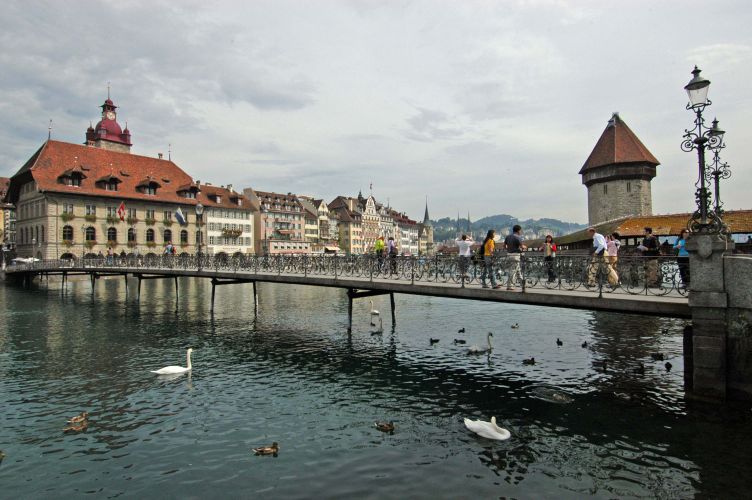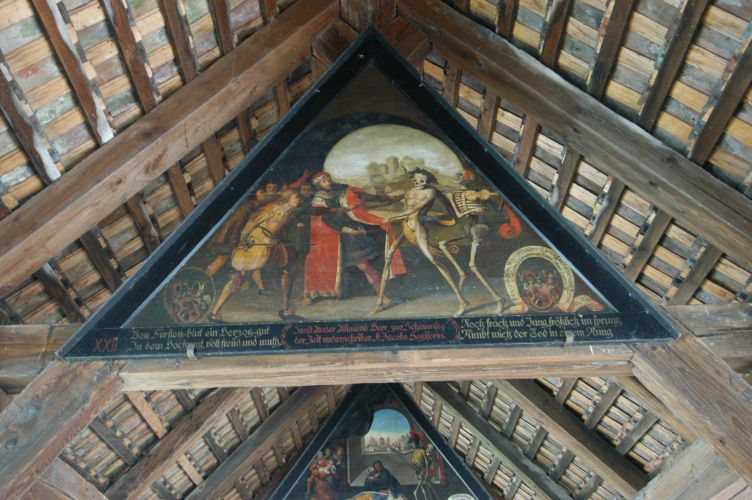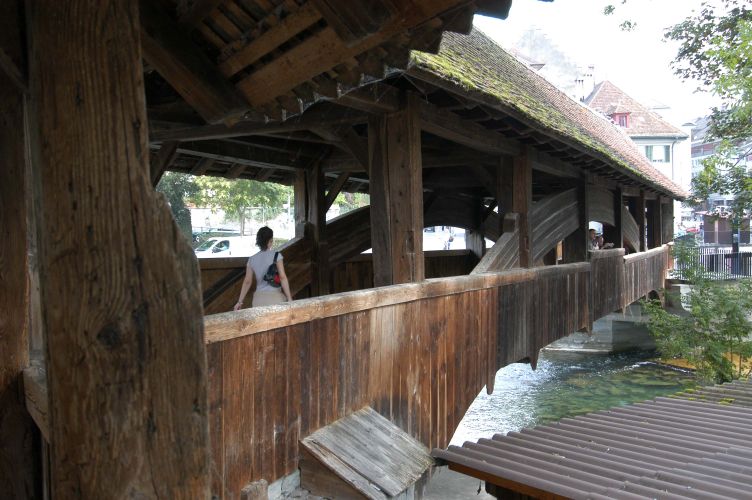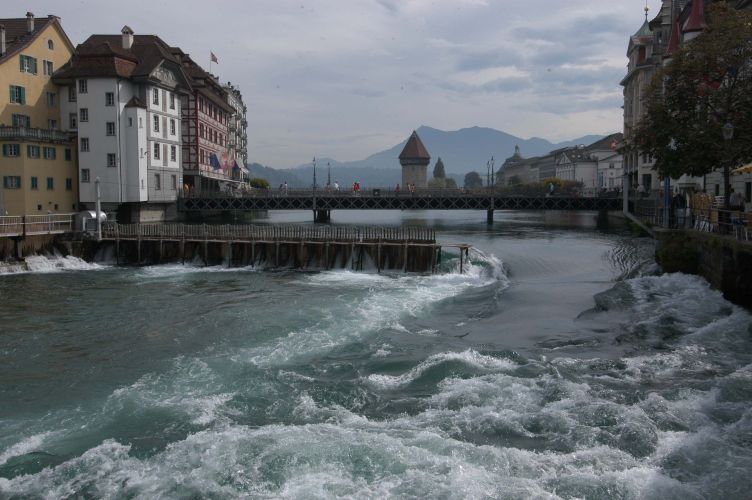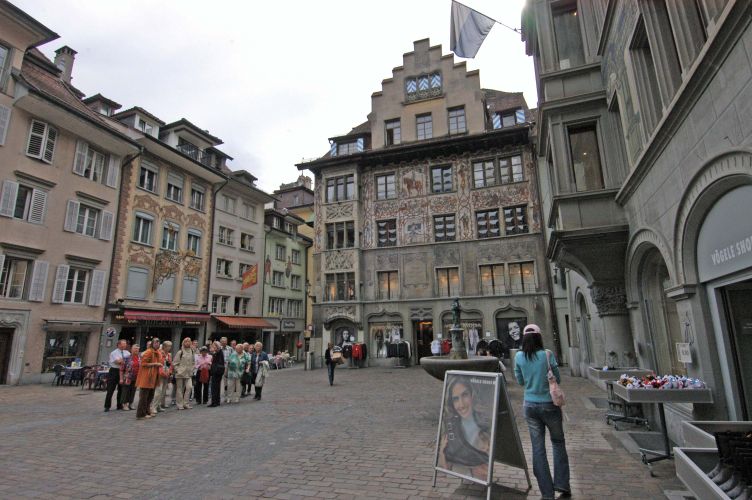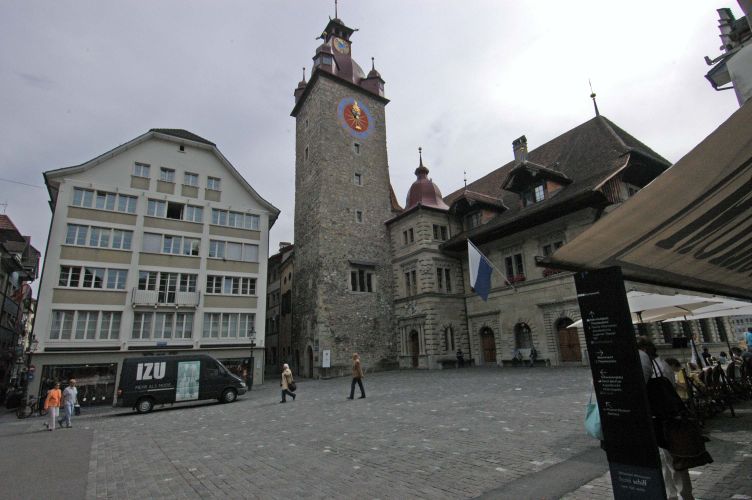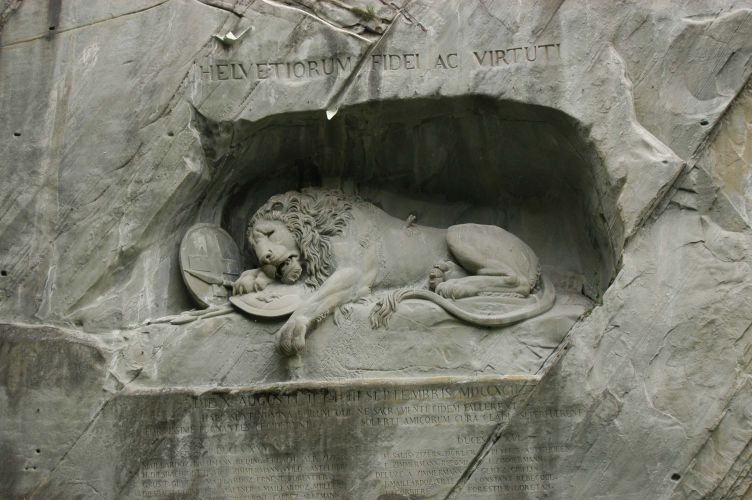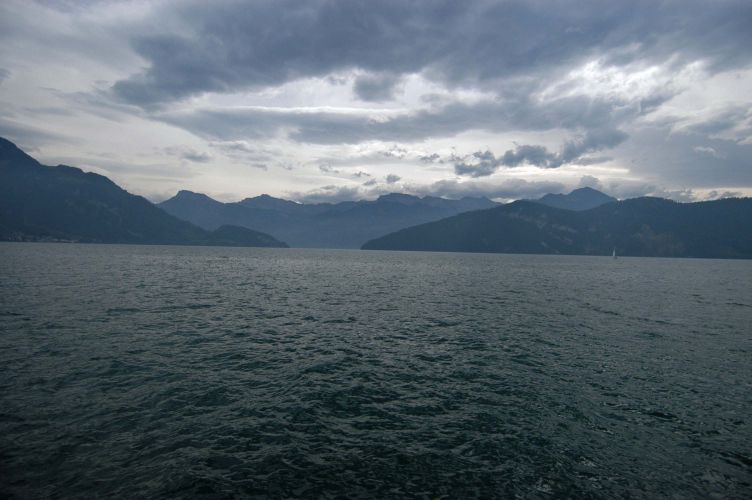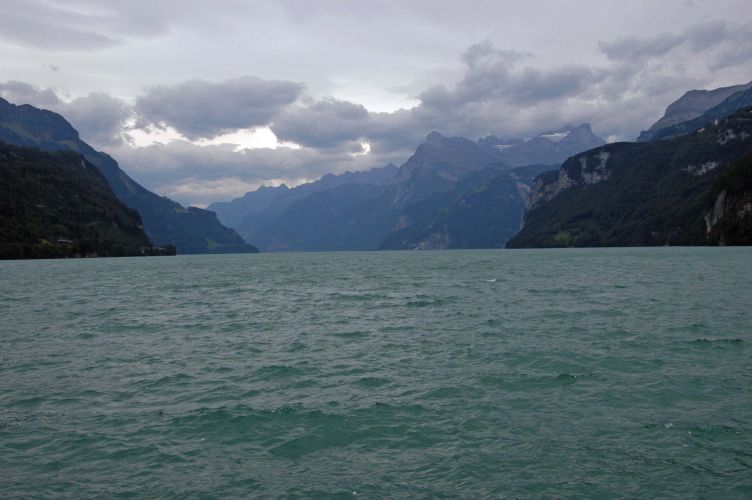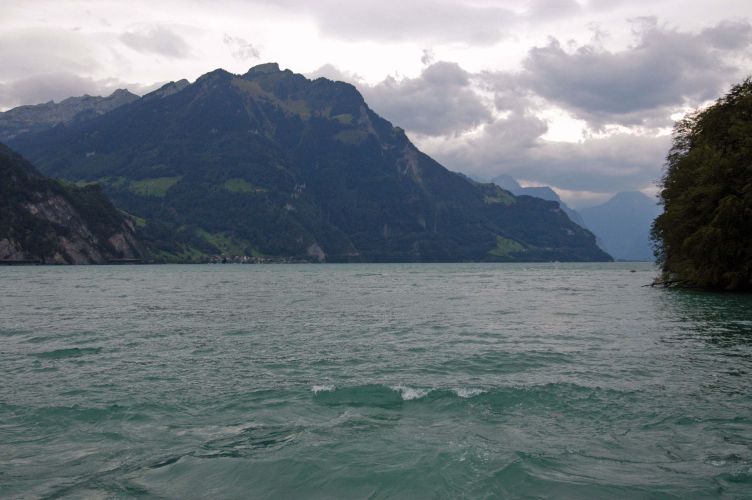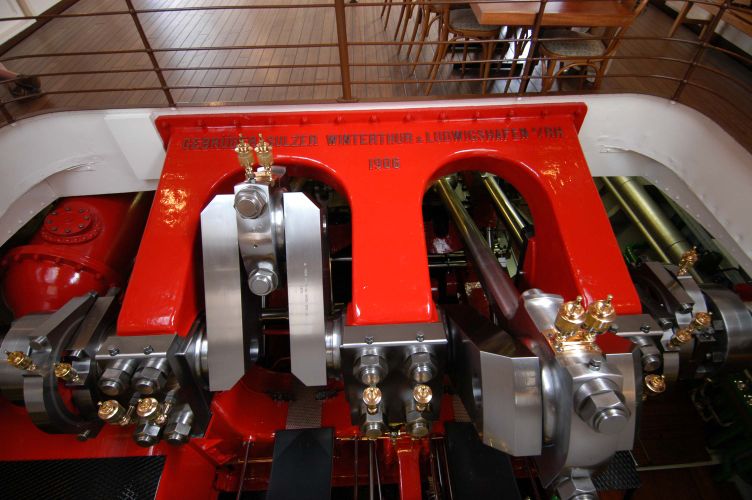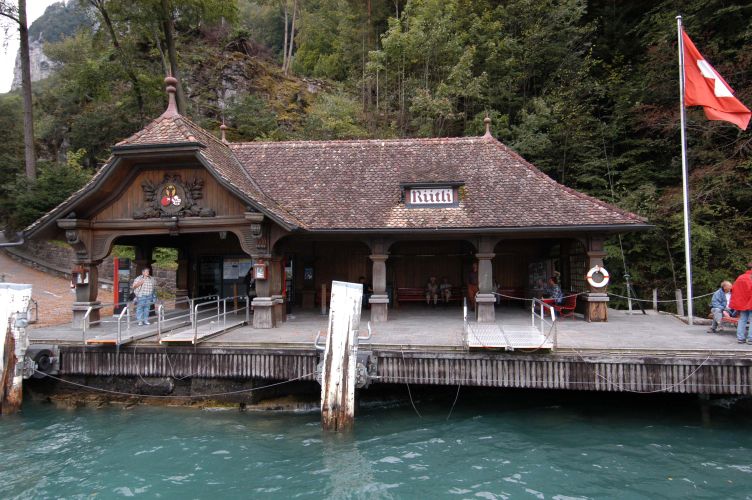Our today's destination is Lucerne. Lucerne (or Luzern in Swiss-German) is a beautiful small city in the heartland of Switzerland. It has long been one of the most visited towns in Europe; perhaps in part because it provides such a storybook image of the Swiss town. When we were researching our trip we picked up AAA Travel guide. The book itself wasn't very helpful as it covered the whole of Europe but the cover photo was that of Lucerne and we knew instantly we had to go there. The image was of the famous Chapel Bridge with swans and ducks swimming in the foreground. We exited the train station and saw it almost immediately, although from a different angle.
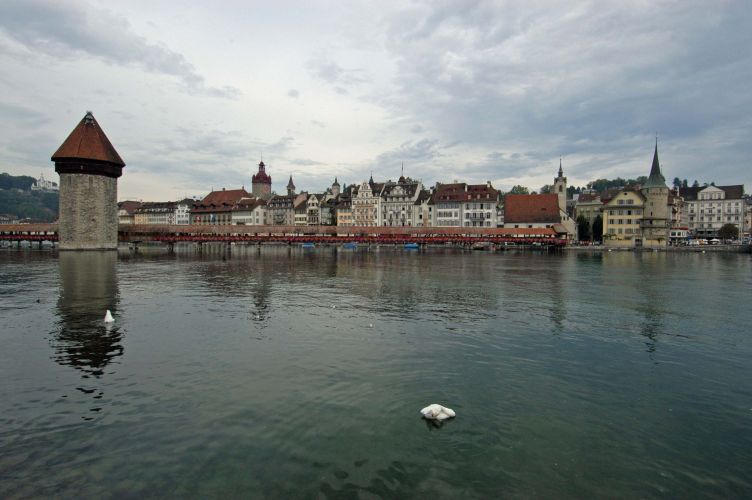
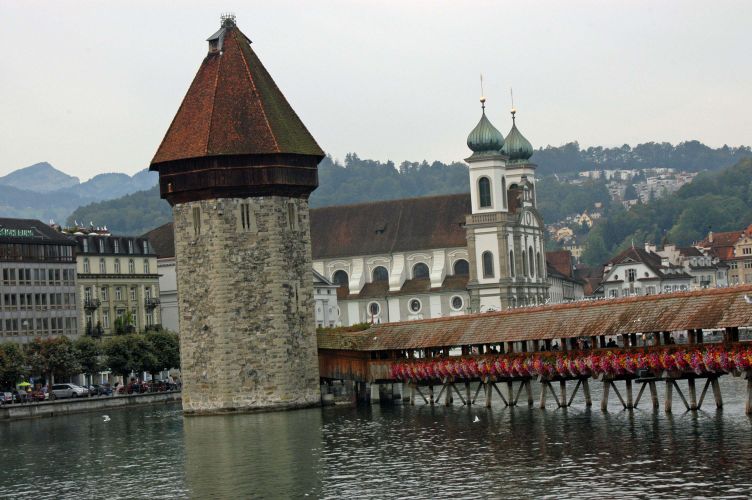 Lucerne is best seen on foot but since not everyone was up for walking we split up. Parents took the trolley tour and we took the walking tour suggested by the guidebook. After a short coffee break (the best coffee we had since Italy!) we made our way to the Chapel Bridge (Kappelbrücke). The covered wooden bridge was constructed in first half of the 14th century as a part of the city's fortifications and named after St. Peter's Chapel, which is located nearby. This original function is probably the reason why it is spanning the Reuss River diagonally from St. Peter's Chapel to the Water Tower. The Water Tower was built around 1300 as part of the city wall and has been used as an archive, treasury, prison and torture chamber. The interior of the bridge is decorated with the 109 murals on its wooden ceiling. The paintings that were added in the 17th century illustrate scenes of Swiss and local history, including the biographies of the city's patron saints, St. Leodegar and St. Maurice. The sides of the bridge are covered by flowers.
Lucerne is best seen on foot but since not everyone was up for walking we split up. Parents took the trolley tour and we took the walking tour suggested by the guidebook. After a short coffee break (the best coffee we had since Italy!) we made our way to the Chapel Bridge (Kappelbrücke). The covered wooden bridge was constructed in first half of the 14th century as a part of the city's fortifications and named after St. Peter's Chapel, which is located nearby. This original function is probably the reason why it is spanning the Reuss River diagonally from St. Peter's Chapel to the Water Tower. The Water Tower was built around 1300 as part of the city wall and has been used as an archive, treasury, prison and torture chamber. The interior of the bridge is decorated with the 109 murals on its wooden ceiling. The paintings that were added in the 17th century illustrate scenes of Swiss and local history, including the biographies of the city's patron saints, St. Leodegar and St. Maurice. The sides of the bridge are covered by flowers.
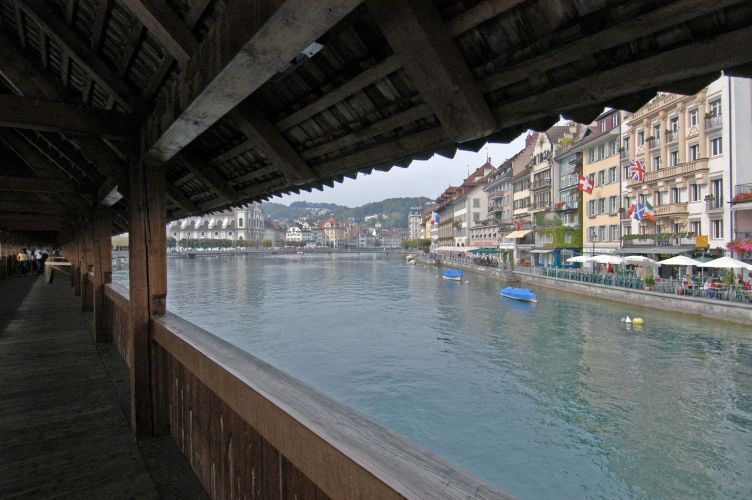
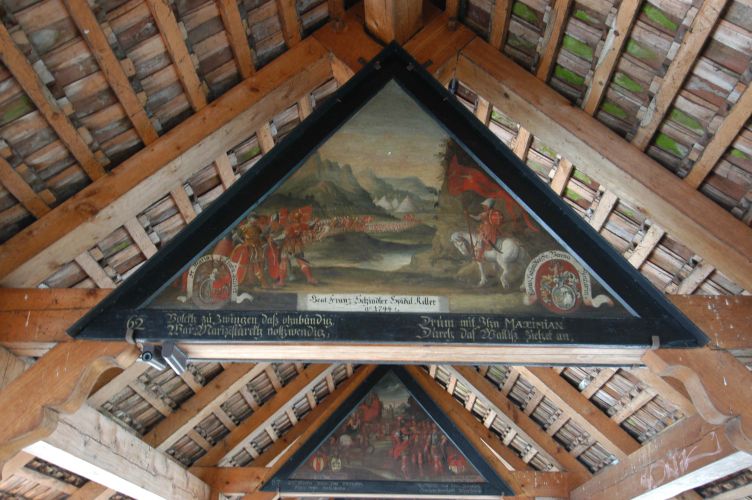 We continued along the riverside to the historic section of town. In some places the sidewalk was built literally over the water. There were swans and ducks floating gracefully in the river. Is this where Hans Christian Andersen found the inspiration for the "Ugly Duckling" He visited the areas in his travels.
We crossed the river again on yet another covered wooden bridge. Spreuerbrücke (Mills Bridge) is the second most famous bridge of Lucerne, built in 1407. It too had paintings at the gables; a very unusual paintings. Medieval-style Dance of Death murals are dating from the 17th century and commemorate a plague that swept through the city.
The bridge also offers a close view of Nadelwerk, the 19th century device to control the river flow. The so-called 'spikes' are lowered or withdrawn by hand into the water to regulate the water level. It replaced in 1859-60 the Reuss steps that channeled the water over the city mills.
The Old Town with its narrow cobblestone lanes and quaint squares is ideal place for strolling and shopping. We didn't have time to shop but we couldn't pass the "BretzelKonig" (Pretzel King) stand. It offered pretzels with dizzying variety of toppings to choose from. We went with the pumpkin seeds. It was delicious! The few of the squares were named Weinmarkt (Wine Market), Kornmarkt (Corn Market) and Muhlenplatz (Mills Square). The Old Town must have been a bustling business center for a quite a while. Weinmarkt was once the town center. It is lined up with the historic building with painted facades and wrought-iron signs. Many of the building were guild houses.
The nearby Kornmarkt is the site of medieval public marketplace. Next to it is the Rathaus, the towered Old Town hall.
Another "must see" in Lucerne is the Lion Monument. This monument is one of the most visited sights in Switzerland. It is terribly sad. The dying lion is draped over his shield with a broken spear in his side. Mark Twain called this sculpture "the saddest and most moving piece of rock in the world". It commemorates the 700 Swiss mercenaries killed in Paris during French Revolution.
In the afternoon we took a cruise on Lake Lucerne. It's among the most spectacular in Switzerland, with mountains on all sides and forests coming down to the shore in many places. There are also so many things to see and do on the shores of the lake and the boat is the easiest and most enjoyable way to get there. We met lots of people getting on and off the boat at different points along the journey.
Our boat was a restored paddlewheel steamer. The steam engine was at attraction in itself. It was built in 1906.
We took the boat across the whole of Lake Lucerne to Fluelen. This trip is also the first leg of the "William Tell Express" tour. That's because we were in William Tell country. We got to listen to the William Tell music when we approached his hometown.
We continued along the riverside to the historic section of town. In some places the sidewalk was built literally over the water. There were swans and ducks floating gracefully in the river. Is this where Hans Christian Andersen found the inspiration for the "Ugly Duckling" He visited the areas in his travels.
We crossed the river again on yet another covered wooden bridge. Spreuerbrücke (Mills Bridge) is the second most famous bridge of Lucerne, built in 1407. It too had paintings at the gables; a very unusual paintings. Medieval-style Dance of Death murals are dating from the 17th century and commemorate a plague that swept through the city.
The bridge also offers a close view of Nadelwerk, the 19th century device to control the river flow. The so-called 'spikes' are lowered or withdrawn by hand into the water to regulate the water level. It replaced in 1859-60 the Reuss steps that channeled the water over the city mills.
The Old Town with its narrow cobblestone lanes and quaint squares is ideal place for strolling and shopping. We didn't have time to shop but we couldn't pass the "BretzelKonig" (Pretzel King) stand. It offered pretzels with dizzying variety of toppings to choose from. We went with the pumpkin seeds. It was delicious! The few of the squares were named Weinmarkt (Wine Market), Kornmarkt (Corn Market) and Muhlenplatz (Mills Square). The Old Town must have been a bustling business center for a quite a while. Weinmarkt was once the town center. It is lined up with the historic building with painted facades and wrought-iron signs. Many of the building were guild houses.
The nearby Kornmarkt is the site of medieval public marketplace. Next to it is the Rathaus, the towered Old Town hall.
Another "must see" in Lucerne is the Lion Monument. This monument is one of the most visited sights in Switzerland. It is terribly sad. The dying lion is draped over his shield with a broken spear in his side. Mark Twain called this sculpture "the saddest and most moving piece of rock in the world". It commemorates the 700 Swiss mercenaries killed in Paris during French Revolution.
In the afternoon we took a cruise on Lake Lucerne. It's among the most spectacular in Switzerland, with mountains on all sides and forests coming down to the shore in many places. There are also so many things to see and do on the shores of the lake and the boat is the easiest and most enjoyable way to get there. We met lots of people getting on and off the boat at different points along the journey.
Our boat was a restored paddlewheel steamer. The steam engine was at attraction in itself. It was built in 1906.
We took the boat across the whole of Lake Lucerne to Fluelen. This trip is also the first leg of the "William Tell Express" tour. That's because we were in William Tell country. We got to listen to the William Tell music when we approached his hometown.
On Swiss maps the lake is called "Vierwaldstattersee," which means "Lake of the Four Forest Cantons". Three of these cantons were the beginning of the Swiss Confederation when they made an alliance at Rutli Meadows. We made a stop at Rutli. So we were visiting the Switzerland's birthplace.
There was some narration provided on the boat in German, French and English. Unfortunately the English version was a lot shorter and not very clear.
In Fluelen we took the train back to Zurich. There was still some daylight remaining when we arrived in Zurich so we took a trolley into town and wondered around the Old Town of Zurich before going back to the hotel.




